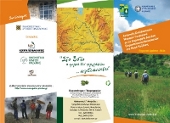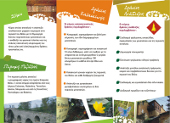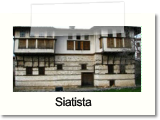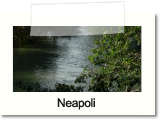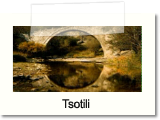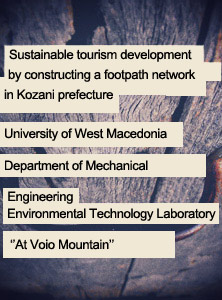
Volunteers
Meteorological indicators
| Fire Indicator |
| Fog Indicator |
News
Project presentation
FUNDING
Partners – Contact
Taliaros and its Role during the Civil War
Taliaros and its Role during the Civil War
Taliaros is the westernmost part of Voio, deep inside the gorges of North Pindos. Its main body begins at Eptahori and ends between Dotsiko and Kalloni, one of its branches, however, reaches south, beneath Vasilitsa and to the villages of Ziaka. It is a peculiarly oblong mountain, that appears to be the same in all its parts, with steep, round slopes, like a giant serpent squashed between the large mountain chains. Its width is small, its length, however, exceeds
Path E6 crosses Taliaros perpendicularly, and connects Pentalofos with the bridge of Zouzouli, but in many spots it has disappeared under the lush vegetation. There used to be a very picturesque village here, Tseros, which was close to Dilofos, but it, too, was raided. Its inhabitants ended up in Dilofos and Krimini. At the foot of Taliaros, the Monastery of Agios Georgios (Saint George) is preserved as well as the temple of Koimiseos tis Theotokou (Dormition), two monuments of exquisite art. Today, visitors can easily access them and admire the wild western side of the mountain, through the new road that was opened to link Eptahori with Dotsiko.
The location of Taliaros has proven to be ideal as a resort, not only of wildlife but of whole armies. Here, as in Zoupaniotikos Ailias, the line of defense of the Democratic Army had been organized, during the bleak years of the Civil War, as these two mountains dominate the landscape of Voio, and are united to obstruct the way to Grammos. In the dense forests, an entire brigade of 600 men had camped, half of which were at the neck of Lykokremasma, which used to be the sole way of accessing Eptahori, and the other half at Dotsiko. Despite the strong fortifications, the defense did not last and on July 2nd 1948 Taliaros was abandoned following a fierce battle. It has remained an abandoned, wild and unknown land ever since, almost virgin to any human activity, hiding well the dark memories of the tragic war. Signs from the ditches of artillery can still be seen, as well as the uprooted trees and the craters opened by bombshells.
In September of ’49 the highest grades of the Primary School of Pentalofos boarded military automobiles which took us to the location “Tria Alonia”, beneath Taliaros. We watched the works of the construction of the public road, which would connect Pentalofos and Eptahori. There was a brief mention of the fierce battles that had taken place in the previous summer in those hills. The cracking of the machine guns and the explosions of the shells were but a memory for us. We enjoyed the lovely scenery. The air reached us full of the aromas of the conifers’ retina. We passed from the drinking fountain and quenched our thirst in our palms. It was a rejoice. The grandeur of nature and the absence of people made the presence of God all the more intense. To us, the children of war, this excursion meant something truly special.
Excerpt from the book “A Village in the Civil War”
GUIDE "IN PATHS OF VOIO"
Topics of Special Interest
- ‘‘Architecture - The Mastorokalfades of Voio’’
- ‘‘The Stony Bridges’’
- ‘‘The Villages of Voio’’
- ‘‘The Visitable Monasteries of Voio’’
- ‘‘The Primeval Oak Trees’’
- ‘‘Ontria – A Rare Geomorphological Phenomenon’’
- ‘‘Nature’s Wonders – Footsteps and Human-like Rocks’’
- ‘‘The Waterfalls of Skotomeno Nero – A Natural Monument’’
- ‘‘The Artificial Lake of Vythos – A New Wetland’’
- ‘‘River Pramoritsa and its Waterfalls’’
- ‘‘The Enormous Cliffs of Haros at Pyrgos Kotylis’’
- ‘‘The Peculiar Geology of Mount Voio – Rare Fossils’’
- ‘‘Voio and the Mushroom Madness’’
- ‘‘Voio - The People’’
- Zoupaniotikos Ailias – Voio’s trademark
- Taliaros and its Role during the Civil War
- Thematic Feasts in the Villages of Voio
- Ecology of Voio
- The European Path E6
- Paliokrimini and the Destroyed Village
- Local Products





